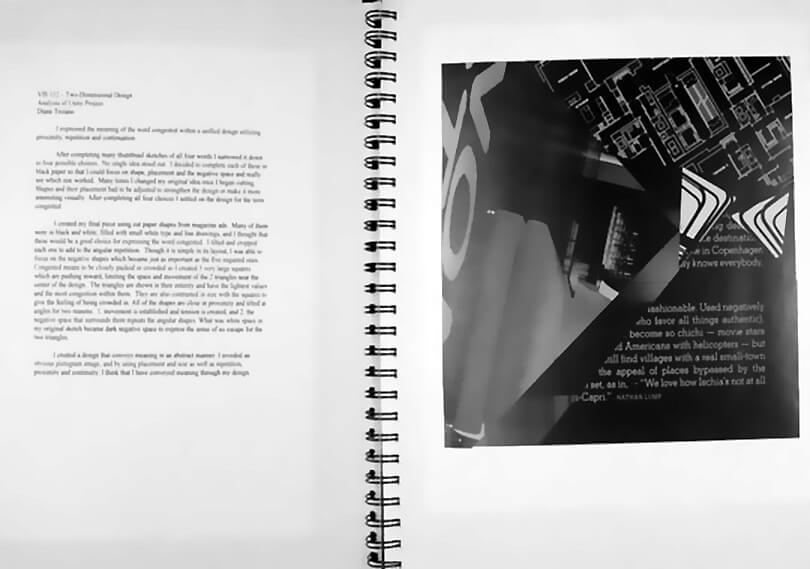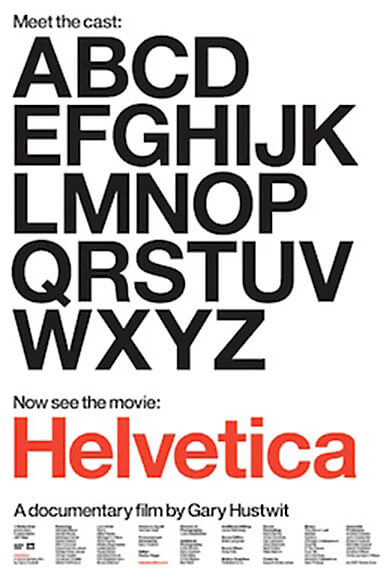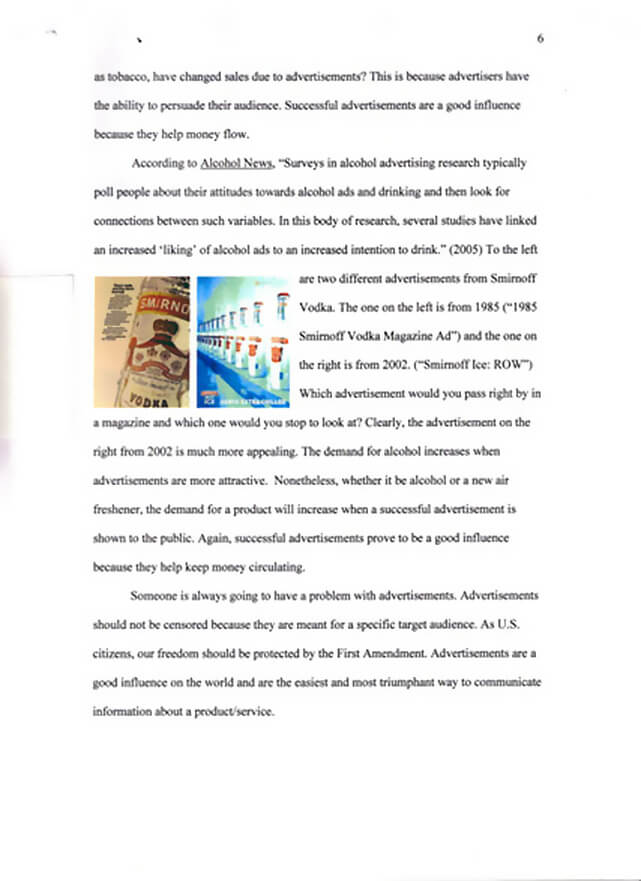Writing and Designing Your Future: A Learning Community That Combines English Composition with Art and Graphic Design
Published in:
November 18–19, 2011
University of Puerto Rico, Rio Piedras and University of the Sacred Heart
San Juan, Puerto Rico
Introduction
On the surface, it seemed a most improbable pairing: Two-Dimensional Design (VIS 112) and Freshman Composition (EGL 101). After all, the first class relies on the precise choice and placement of images; the second, on the precise choice and placement of words. But two semesters later, it was more than apparent that the unlikely pairing of classes proved to be a perfect fit, as we found that our cluster class Writing and Designing Your Future: A Learning Community that Combines English Composition with Art and Graphic Design helped improve teaching and learning in exciting new ways.
Rationale
According to “Clustering Courses to Build Student Community,” “… common course scheduling and the use of teams within individual courses promote the development of a small community atmosphere.” Students develop strong friendships within their clusters and are likely to study together. They are also more likely to coordinate their course schedules for subsequent semesters. Further, first and second year retention of students in learning communities, such as clustered courses, is frequently greater than for non-clustered students (Source: 32nd Annual Frontiers in Education: Clustering Courses to Build Student Community. Boston, MA, 2002).
Background
When Dr. Beverly L. Kahn, Professor of Political Science and Title III Project Director, won the five-year $2-million Title III “Strengthening Institutions” grant from the US Department of Education, we started mulling over a possible partnership. In the fall of 2010, before funding was available, we piloted the learning community. The following year, pleased with the result of our efforts to teach students to write clearly, logically, and persuasively, we applied for and received a grant to extend our collaboration.
Our learning community — also referred to as a “cluster class”– contained 20 students enrolled together in two classes linked by a common theme, graphic design, effectively broadening the cogitative landscape for Visual Communications majors and engaging students in writing that is relevant to their selected vocation.
Visual Communications 112 is a required course for Graphic Design freshman. This course is the foundation of the discipline, teaching and practically applying the principles and elements of design. However, unlike Visual Communications 112, English 101 is a required course for all incoming first-year students in all majors. This course is the foundation of the college writing, as students learn the writing process and explore expository, persuasive, narrative, and descriptive writing.
Despite their different missions, both classes have significant writing components.
- VIS 112, as taught by Professor Fernandez, requires students to produce a visual journal or “Playbook” that comprises summaries of 12 visual problems in the form of separate chapters; and a written self-evaluation of the strengths and weaknesses of each student’s work. Thus, students not only develop visual responses to communications problems, but also produce written analysis of project outcomes, the idea behind them, and the creative process.
- English 101, as taught by Professor Rozakis, requires students to write 11 high-stakes essays of 350-500 words each, focusing on persuasive, expository, and narrative modes of discourse and a persuasive research paper of 5-7 pages. The class also includes daily low-stakes assignments.
Clearly, we both recognize that writing is the primary basis upon which our students’ work, learning, and intellect will be judged—in college, in the workplace, and in the community. We are committed to the idea that writing equips students with the communication and thinking skills they need to participate effectively in democracy. Perhaps most important of all, we know that writing expresses who we are by making our thinking visible.
Advantages of Our Learning Community
Improved Critical Thinking and Writing Overall
Not surprisingly, many of the VIS 112 students were initially shocked at being required to analyze their artwork in writing, arguing that they had signed up for an art class, not a writing class. This took a bit of adjustment on their part.
We found that our learning community built improvement in clarity, logic, and persuasiveness by nurturing a “writing habit” through our two courses, back to back, in an area where students have a vested interest. By giving students greater “buy-in,” we found that they wrote in both classes with greater interest, attention and determination. This led to increased learning and recall. We found that:
- students were more interested in writing because it directly pertained to their career plans,
- the writing was different and interesting because it integrated visuals,
- and the writing showed greater improvement than usual.
Improved Quality and Quantity of Writing in VIS 112
Notably, the VIS 112 students wrote more and wrote with greater ease, as the following page from a Playbook shows. Note the writing on the verso page, significant for its length as well as depth. This increase in quantity and quality was noteworthy.

Many of the students in the EGL 101 class also showed striking differences in their essays, most notably in their incorporation of visuals with text, a truly different way of approaching the writing task. Our learning community students looked at writing as a visual creation, the words and letters as artistic symbols in addition to conveying meaning. This was shown most clearly in the following research paper on the topic of the font Helvetica, in which the writer argued that Helvetica had revolutionized communication, a topic that evinces a perfect melding of his interest in two-dimensional design in VIS 112and the requirements of persuasive writing in EGL 101.
As the following sample page from the student’s report shows, he used a visual example to argue the effect of san serif type on our impression of an object being named: we perceive the object as “cleaner” and “more modern” because of the type face used as its signifier. This is extremely sophisticated thinking and writing for a first-year student.
Below is a sample page from his research paper:

Another student in the EGL 101 part of the cluster class analyzed the elements of designs in advertisements, using the ads as her jumping-off point, as the following sample page from her report shows.

Many variables affect student success. Most notably, many first-year college students often lack the academic preparation, maturity, and self-awareness necessary for success in higher education. Further, each professor views a student from his or her own point of view, often colored by the student’s talent and success in the specific academic discipline. Students react to us differently as well, based on such factors as our subject matter, teaching style, gender, age—even our fashion sense. Finally, the time of day the class meets affects a students’ performance, as students are likely to be far less alert during an 8:00AM class than they are later in the day.
By working together, we were able to get a far more nuanced view of each student. We learned more about our students by comparing our impressions and findings, and thus better helped each individual succeed. We saw how students interacted with each other and the subject matter in each class and built upon those experiences to lay the foundation for their college career.
Disadvantages of Our Learning Community
Lack of Variety
In EGL 101, most of the papers were on similar topics because all of the students have similar interests. This narrow focus doesn’t expose the students to other significant issues, such as economics, health care, taxation, and politics, important issues for creating a well-rounded citizen capable of critical thinking.
Further, since the students all have the same major, class readings and discussions were narrowly-focused as well. This again did not allow for the usual range of topics covered in professional essays and discussions in traditional English 101 classes.
Scheduling Issues
Scheduling was tricky, as students were required to register for both the EGL 101 class and the VIS 112 class. The agreed-upon class size for each discipline was an issue as well, especially regarding budgetary issues. These issues were resolved in the short-term, but the future remains cloudy regarding accommodations to the needs of this special class.
Increased Preparation
Professor Fernandez was eager to try the cluster class experiment because he had found that the writing component of his students’ journals has always fallen short of his expectations, with the lack of in-depth analysis being a major issue. He felt this is largely a result of the time-consuming reality of turning around 12 finished pieces of art during the semester, leaving less time for quality writing. Melding our classes resulted in improved writing, as covered earlier in this article, but also entailed additional preparation, conference time, and grading.
Summary
We regard our experiment a success and would eagerly continue it, building on our reflections from the past two years.
Spring 2012: Emerging Pedagogies for the New Millennium
